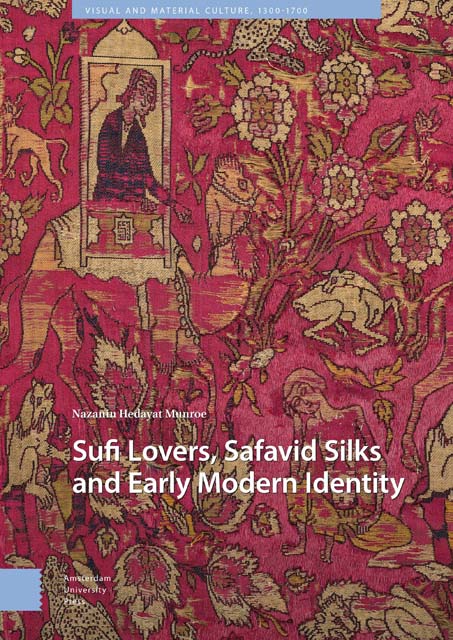Book contents
- Frontmatter
- Dedication
- Table of Contents
- Acknowledgments
- List of Illustrations
- Note on Transliteration
- Introduction: Material Culture and Mysticism in the Persianate World
- Part I
- Part II
- Conclusion
- Appendix A List of Khamsa Silks
- Appendix B Summary of ‘Shirin and Khusrau’ by Amir Khusrau Dihlavi
- Appendix C Summary of ‘Majnun and Layla’ by Amir Khusrau Dihlavi
- Glossary of Textile Terms
- Glossary of Persian and Arabic Terms
- List of Historic Figures
- Index
Introduction: Material Culture and Mysticism in the Persianate World
Published online by Cambridge University Press: 19 April 2023
- Frontmatter
- Dedication
- Table of Contents
- Acknowledgments
- List of Illustrations
- Note on Transliteration
- Introduction: Material Culture and Mysticism in the Persianate World
- Part I
- Part II
- Conclusion
- Appendix A List of Khamsa Silks
- Appendix B Summary of ‘Shirin and Khusrau’ by Amir Khusrau Dihlavi
- Appendix C Summary of ‘Majnun and Layla’ by Amir Khusrau Dihlavi
- Glossary of Textile Terms
- Glossary of Persian and Arabic Terms
- List of Historic Figures
- Index
Summary
Abstract
Introducing the relationship between weaving and poetry, this chapter presents the study as one bringing together seemingly disparate elements as the foundation of early modern cultural and behavioural norms. Nizami Ganjavi (d. 1209) is cited as the poet whose Khamsa (Quintet) codified two legendary romances: ‘Khusrau and Shirin,’ a love story about besotted royals from Iran and Armenia, respectively; and ‘Layla and Majnun,’ a tale of young Bedouin lovers separated by family strife. Both tales take place in the pre-Islamic era, yet are adapted to medieval Islamic audiences, with strong Sufi mystic references embedded in the text. The Persianate realm is introduced as a broad transnational expanse from Iran to South Asia, unified in the early modern period by the Persian language and Sufi literature.
Keywords: Safavid, Mughal, Amir Khusrau, silk, ‘ishq, futuwwat nama
This book addresses the relationship between poetry and textiles by examining a unique group of narrative figural silks depicting lovers from the Khamsa (Quintet) of epic poems. Attributed to early modern Safavid Iran (1501-1722), these sumptuous silks were coveted luxury commodities while simultaneously embodying mystical concepts codified in Persian literature. Messages conveyed through figural silks will be analyzed in Safavid and Mughal courtly cultures, as well as in Sufi and Islamic traditions that guided early modern rulers, who fashioned themselves as ‘dervish kings’ through a shared visual and literary culture. By contemplating luxury dress as a form of self-expression, the portrayal of Khamsa textiles functions as an important link expressing worldly and spiritual identities.
The legendary characters depicted on the silks were codified by twelfth-century Persian-language poet Nizami Ganjavi in his Khamsa, whose enthralling tales of these historical figures were imbued with Sufi mysticism. ‘Khusrau and Shirin’ dramatizes the love story of Iranian king Khusrau and his Armenian queen Shirin, whose tumultuous royal relationship began with a fated meeting on the road between their two kingdoms. ‘Layla and Majnun’ recounts the separation and madness of the Bedouin poet-lover Qays (aka Majnun, ‘Madman’) and his beloved Layla, and his transformation from insanity to sublimity as he wandered through the wilderness. Hailed as one of the great classics of Persian literature, illustrated manuscripts of Nizami’s Khamsa were produced by workshops throughout greater Iran for the ruling classes in the centuries leading up to the Safavid period, including scenes illustrating each set of lovers meeting privately.
- Type
- Chapter
- Information
- Sufi Lovers, Safavid Silks and Early Modern Identity , pp. 17 - 24Publisher: Amsterdam University PressPrint publication year: 2023



